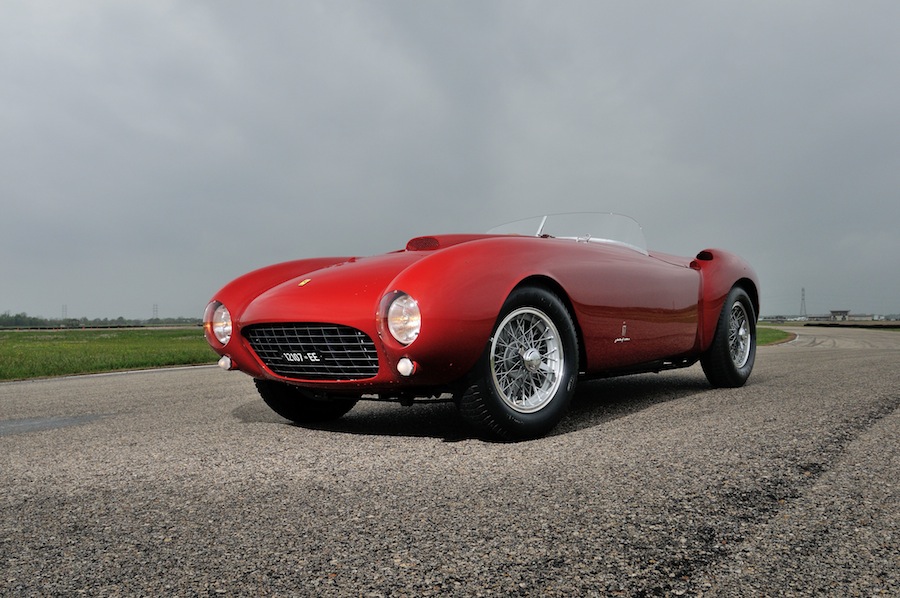
A rare 1954 Ferrari 375 MM Spider By Pinin Farina, Chassis No. 0362AM is scheduled to be auctioned on August 16, 2014 in Monterey, California. The auction is held at Hyatt Regency Monterey Hotel and Spa on Del Monte Golf Course.
The 1954 Ferrari 375 MM Spider, designed purely for the rigors of endurance racing, the Ferrari 375 Mille Miglia also furthered Ferrari’s reputation for building superb dual purpose sports machines while establishing Pinin Farina as Ferrari’s coachbuilder of choice. The 375 MM first appeared at the 1953 24 Hours of Le Mans. Fundamentally it combined a 340 MM chassis with the 4.5 L/340 HP V-12 developed for the stillborn Indianapolis 500 project. Weighing in at just 2,000 pounds, the 375 MM in Berlinetta form set a lap record at the Sarthe that year before retiring. Later that same year another 375 MM took fourth place in Mexico’s Carrera Panamericana, sealing the first of Ferrari’s many Manufacturers World Championships.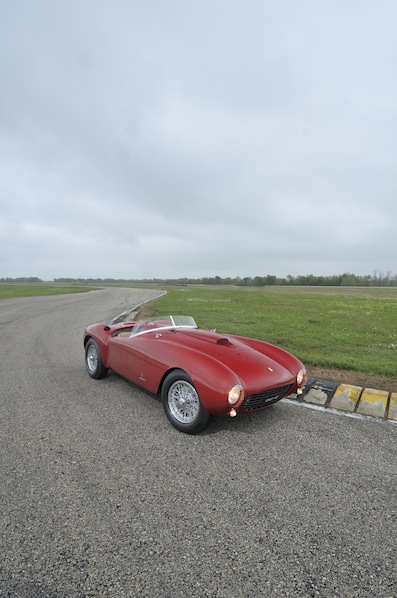
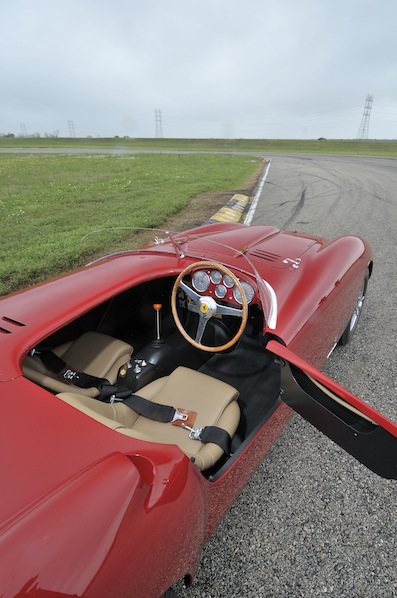 According to various sources, Pinin Farina built sixteen open coachwork 375 MM cars with serial numbers from 0360 AM to 0460 AM. In early 1954 this Pinin Farina-bodied spider left the Ferrari factory destined for delivery to Southern California construction magnate Anthony Parravano.
According to various sources, Pinin Farina built sixteen open coachwork 375 MM cars with serial numbers from 0360 AM to 0460 AM. In early 1954 this Pinin Farina-bodied spider left the Ferrari factory destined for delivery to Southern California construction magnate Anthony Parravano.
The chassis frames were fabricated in small lots by Gilco Autotelai and sent to Ferrari to have the suspension, brakes, steering and mechanical units installed. The rolling and operational assembly was sent to Pinin Farina for the installation of the body, paint and finish work. This car was exported with chassis frame stamped 0362 AM, identification plate stamped Tipo 102, number 0362 AM, and chassis stamped with Gilco sequence number 10. Pinin Farina job number 12569 was stamped on the back of the dash panel and scratched on the underside of the windshield frame. The steering gearbox #144 listed on the original data sheets for the car remains in the car to this time.
After the car’s arrival and preparation at Parravano’s Los Angeles shop, in April or May of 1954 it made its maiden run at El Mirage dry lake, where it hit a remarkable top speed of 172 MPH. Its first organized sports car event came on June 6, 1954 at the third annual Guardsman Campership Road Races in San Francisco’s picturesque Golden Gate Park. Manhattan Beach foreign car dealer Jack McAfee drove 0362 around Bill Stroppe’s Mercury-Kurtis to handily win the main event before an astonishing crowd of 100,000. On July 4 at Offutt Air Force Base near Omaha, Nebraska, McAfee once more took the winner’s trophy in the SCCA-sanctioned Offutt National Sports Car Races.
Tony Parravano was always on the lookout for new driving talents, and he found one in young Manhattan Beach dive boat operator Bob Drake, who had already shown speed in an MG. On October 17, 1954, Drake confirmed Parravano’s instincts, driving 0362 to a decisive victory over a tough field in the fifth annual Palm Springs Road Races.
The next big outing and a pivotal point in the car’s history occurred on March 13, 1955, across the country at Sebring, Florida in the 12 Hours of Sebring. The car suffered several teething problems in practice, including a water leak from the back of the engine block. John King, a young GE engineer from Cincinnati, by way of California, was invited by Parravano’s crew chief to join the team at Sebring; the night before the race he noticed a puddle of water on the floor beneath the engine and was assigned the job of finding and fixing the leak. In a letter written to the car’s co-owner Charles Betz 56 years later, King described cutting a hole in the firewall from inside the cockpit to access the faulty stud, which he replaced by drilling out and tapping the cylinder head for a larger diameter stud. Years later during 0362’s restoration the opening and cover plate in the original firewall panel helped establish its originality to the car; it was then returned to the original configuration.
As most always happens in endurance racing, then and now, all the work and preparation were for naught. After getting off to a strong start out of the Le Mans formation, Jack McAfee failed to show on the seventh lap. The Ferrari had caught fire; McAfee failed to put it out with the car’s extinguisher, but a nearby crew quickly put an end to it. However, this was after McAfee got back into the burning car (with forty gallons of fuel in the tank) and drove it to the fire truck!
Parravano and crew wasted no time returning to California and repairing 0362. Just two weeks after the Sebring fire the car was on the grid for the Palm Springs Road Races, the damage from the Sebring fire repaired and the body sporting new Maroon paint. Jack McAfee was back at the wheel, winning the race for the second time after a hair-raising three-way duel with Tom Bamford’s Cad-Allard and Bill Pollack in his Mercury-powered Baldwin Special.
Driving the car again on May 1 at Bakersfield, California, in the main event McAfee, after passing a Ferrari Monza for the lead, uncharacteristically overcooked it entering a corner and rolled the car. McAfee emerged unscathed, but the damage to the car was extensive enough that Parravano decided to modify and lighten it by shortening the wheelbase, with the intention of rebuilding it for the 1956 Carrera Panamericana. The plan was dropped when the race became one of many cancelled after the 1955 Le Mans disaster.
By 1957 Anthony Parravano was involved in a dispute with the IRS. As business troubles mounted, he moved to transport several of his cars to Mexico to avoid their impending seizure and sale by the IRS. Some made it over the border to Ensenada, where they were placed in storage and later sold by the family. Ultimately the remainder of Scuderia Parravano’s known assets were sold off in at least two major IRS auctions. Parravano himself inexplicably disappeared in April of 1960, just three days before an appointed court date in which he fully expected to finally resolve the tax case; he would never be seen again.
The modified, but not completed, 0362 chassis was purchased by another Los Angeles construction contractor, Frank Arciero. The package included the Sutton-bodied 375 Plus 0478 and two Maserati 4.2 L V-8 Indianapolis engines. The cars, and engines, were picked up by Arciero’s shop manager Bill Fowler. He would later become a key member of Dan Gurney’s All American Racers. The parts of 0362 that remained with Scuderia Parravano, as well as several other cars and the Parravano parts inventory, were bought by “Colonel” Bill Sorrell, whose son Bob later took ownership after his passing; years later they became crucial to the car’s restoration.
Arciero finished the modified 0362, fitting a Mistral Spyder fiberglass body shell, and entered it in the 1958 Times-Mirror Grand Prix at Riverside. Showing the skills that would make him one of America’s racing legends, 27-year-old Californian Dan Gurney drove the car to second place behind skilled journeyman Chuck Daigh in his Scarab. The field of cars and drivers was probably the best seen in United States sports car racing to this time.
From 1958 through 1961 0362 was a regular entrant in major events and SCCA races, driven by emerging stars Gurney, Bob Bondurant, Skip Hudson, Don Hulette and Otto Becker. During that time Arciero performed regular upgrades to 0362 to maintain its competitive edge with qualifying times at major venues actually improving until 1960.
In 1959 Arciero installed in 0362 one of the Maserati 4.2 Indianapolis engines he acquired from Scuderia Parravano. Its first race with the 4.2 was the October 25 SCCA Sports Car Road Race, in which driver Skip Hudson finished third. It went on to compete at Nassau, Riverside and Pomona, during which time Arciero regularly advertised the car for sale in Motoracing and other publications. Its last major outing under Arciero’s ownership was on October 16, 1961 in the Riverside Grand Prix for Sports Cars; driver Don Hulette finished third in the consolation race but failed to finish the main event.
In 1965 Arciero sold the car to Whittier, California collector Ron Kellogg. At that point it was painted Gold and was fitted with a new Kamm style tail, but through the years it had retained the original Ferrari 375 MM front frame section, suspension, steering system, differential, wheels and brakes.
In 1968 Charles Betz and Fred Peters purchased the rolling chassis and spare wheels from Ron Kellogg and began to locate and purchase the missing components. Some parts were purchased from the inventory of Luigi Chinetti. In the 1980s Betz and Peters sourced many parts exclusive to the 375 MM, including an original “electron” magnesium case transmission from 0364 AM (Tipo 102/comp, #3/D), from Newport Beach collector Ernie Beutler, who had owned several Lampredi-engined race cars.
For years Betz and Peters had visited Bob Sorrell and tried to purchase from him the rear frame section removed from the car when Parravano decided to modify it. The frame section rested tantalizingly against the wall in his shop, along with the engine cover and metal tonneau cover. He refused to sell any part for many years.
In 1986 Bob Sorrell sold his inventory of Parravano cars and parts to renowned Ferrari restorer and DK Engineering founder David Cottingham. Before shipment to England he graciously allowed Betz and Peters to help him sort and prepare the cars and parts for shipment to England and retrieve all the pieces originally part of 0362. To the delight of Betz and Peters the inventory included a prodigious quantity of parts from 0362, far beyond what Betz and Peters had seen against Bob’s wall. Among his inventory were the identification plate (carried in his wallet for many years!), the missing frame section originally removed in shortening the wheelbase; the firewall, floor pans, transmission cover, belly pans, passenger seat, hood, door, metal tonneau cover, radiator cap access door, headlight buckets, windshield frame; gas tank, radiator and oil cooler, gearshift knob, driveshaft, dash panel and numerous other pieces. All the body parts were identifiable by the unique color of the Maroon paint on the body panels and the grey paint on the interior pieces applied to them by Scuderia Parravano.
The restoration of 0362 then began in earnest. Steve Beckman of Beckman’s Metalworks in Costa Mesa, California, had done all of Betz and Peters’ metal work for over twenty years; he reunited the front cross member and the rear frame section, returning the frame to original specifications and attaching the original belly pans, floor pans and firewall. Using the ex-William Holden, Horace Jeffrey, and now Fred Simeone car (0412) as a model, Beckman also made a complete body buck and reproduced the missing body parts to fit the original pieces and complete the body.
At this time the Parravano family kindly provided original photos from 1954 and 1955 to Betz and Peters. From those images it was determined that the original body on 0362 was slightly different from later examples, including 0412, necessitating some final revisions. Betz and Peters were also given access to the virtually identical 0384 car to make the additional templates necessary to correctly complete the bodywork. The thin coat of Maroon paint applied by Scuderia Parravano after the Sebring fire was carefully sanded away from the original passenger tonneau cover, revealing the Rosso Corsa paint applied by Pinin Farina. Samples from the original paint on the firewall, belly pans and interior were also carefully matched.
Today the car carries engine 0376 from the 375 MM Spyder of that number, internal number 204 and the “electron” case transmission supplied by Ernie Beutler from 0364. The lights, switches, and instruments (including the chronometric tachometer) match the specifications of 0362 as when it left the Ferrari factory for shipment to Anthony Parravano in 1954.
The completed 0362 was presented for display at the Ferrari Club of America meet in Indian Wells in November, 2012. In August of 2013 it was at the Carmel Concours on the Avenue, where it won Best of Show.
The spectacular restoration of this storied Ferrari effectively closes the circle on its history as the most successful car in Scuderia Parravano’s brief but dramatic reign over West Coast sports car racing in the 1950s. It also positions her to embark on the next chapter in that history. Now as then, 0362 is both an aesthetic and a mechanical masterpiece that will enchant in any setting, from the Cavallino Classic, Villa d’ Este and Pebble Beach Concours d’Elegance, the Colorado Grand or California Mille, and on to the track at Monterey’s Motorsports Reunion and countless other vintage racing events.
Whatever the venue, 0362 and her fortunate new owner will find a place of honor ready and waiting. For additional information and photos visit www.Ferrari0362AM.com
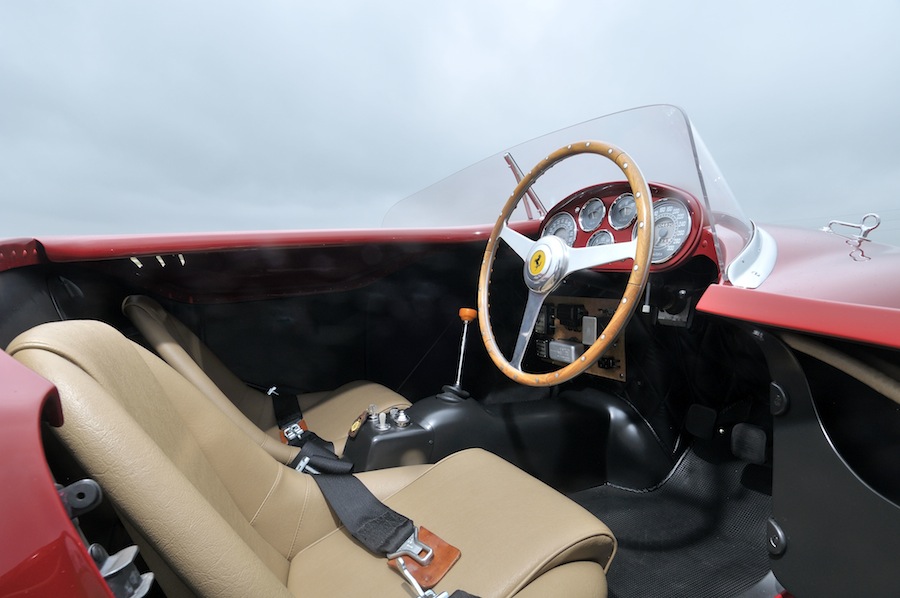
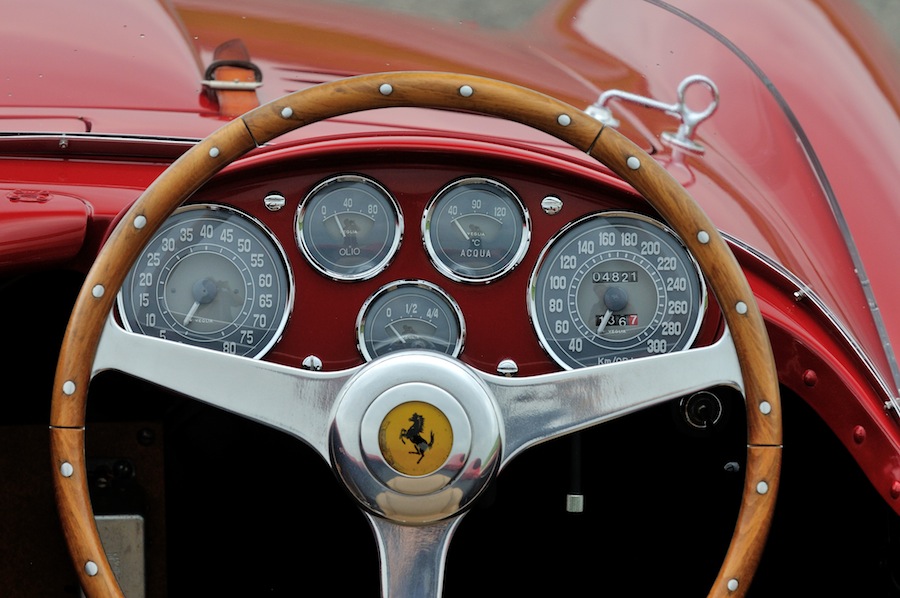
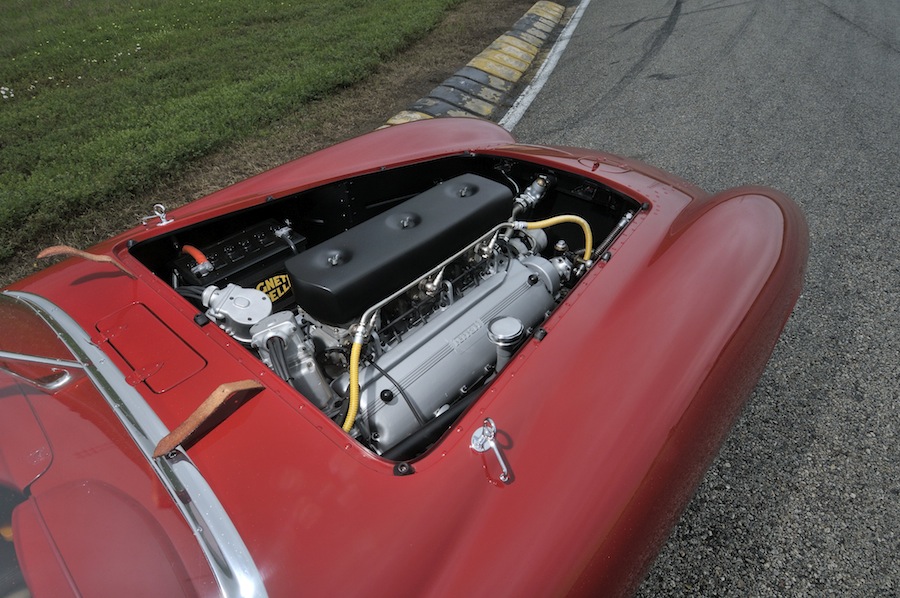
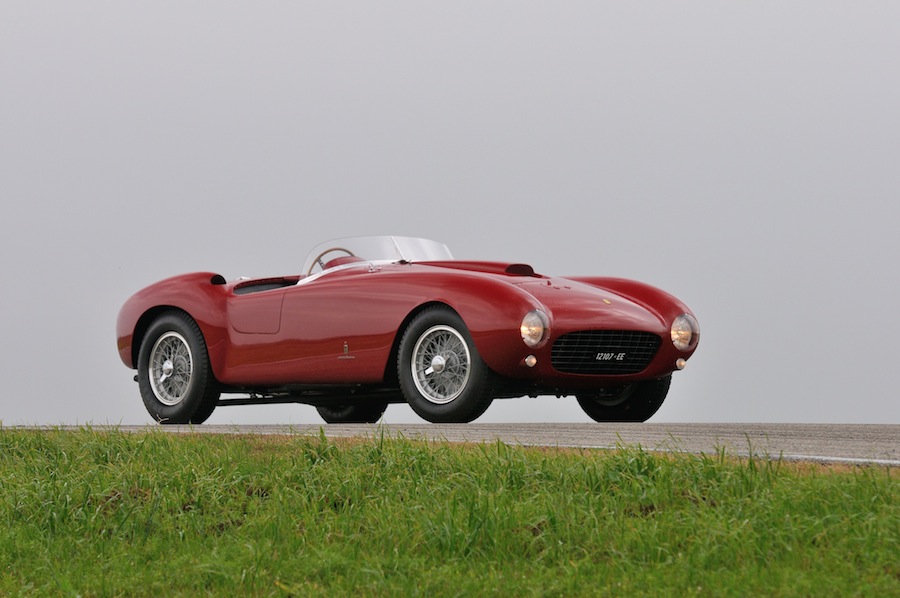
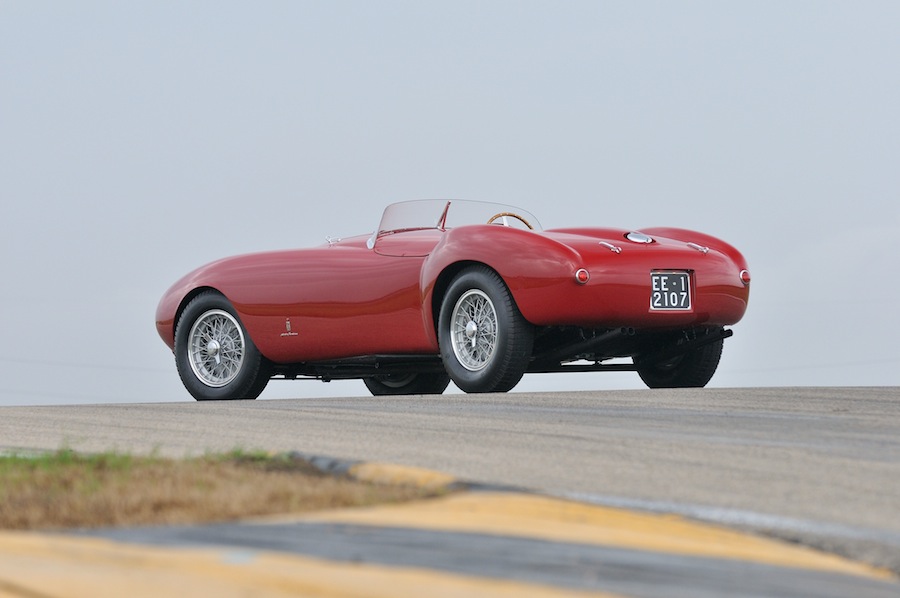
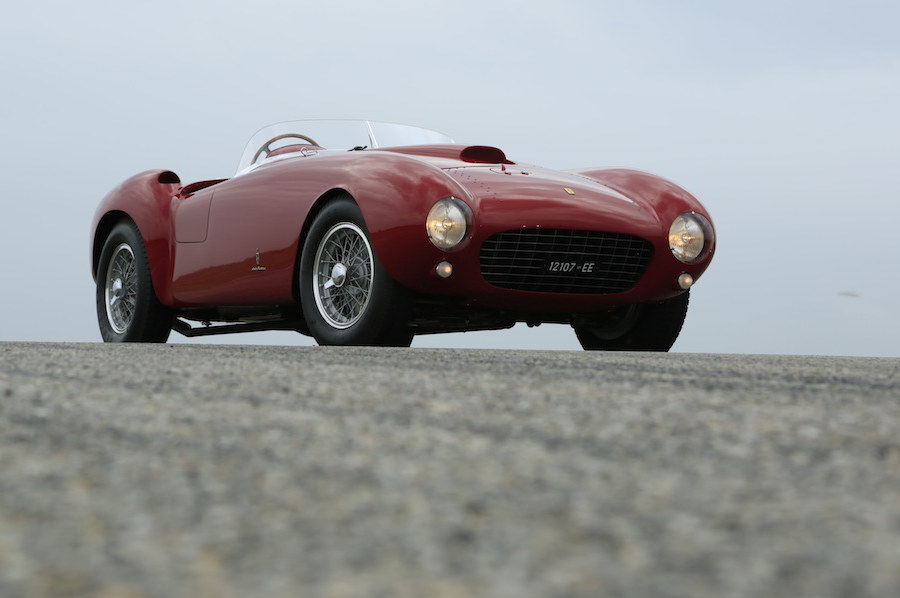

You must be logged in to post a comment.